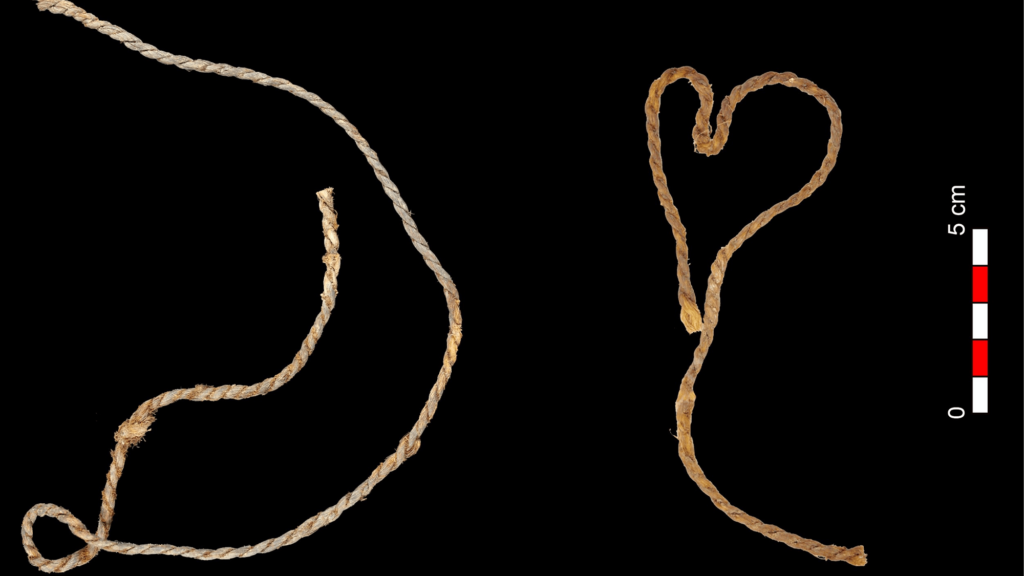[ad_1]
An international team of archeologists found the oldest known bowstrings used for archery in a Spanish cave. The hunting tools were likely built by the Neolithic humans that called the Iberian Peninsula home about 7,000 years ago. An analysis of the materials in the bowstrings and arrow shafts reveal that they were made from the tendons of three different animals and various local woods. The findings are described in a study published December 5 in the journal Scientific Reports and reveals that these prehistoric humans had a high degree of technical mastery.
Projectile weapons like throwable spears and bows and arrows were believed to have appeared very suddenly among modern humans living in Eurasia 45,000 years ago–during the Upper Paleolithic period. However, a 2022 study uncovered 54,000-year-old dental remains from modern humans at this same site, suggesting that they were in the area about 10,000 years earlier than scientists previously believed. A 2023 study later found that bows and arrows likely accompanied them on this cross continental journey.
These new archeological remains were uncovered in the Cave of Los Murciélagos in Albuñol, Granada, Spain. Neolithic populations inhabited this southwestern part of the Iberian Peninsula around 5300 to 4900 BCE. The organic material within the bowstrings was exceptionally well preserved because they have been dried out in the cave over thousands of years.
[Related: A javelin-like stick shows early humans may have been keen woodworkers.]
The team applied advanced microscopy and biomolecular analysis techniques that combine protein and lipid analysis to study organic material left behind in the materials. This allowed them to identify the materials used to make this ancient hunting equipment. The bowstrings were made from the animal tendons belonging to a genus that includes several species of goats and ibex, a genus of wild boar and pigs, and the roe deer. The bowstrings were then twisted together to create long ropes. Using this twisting technique, flexible ropes could be fashioned that the team believes could meet the needs of experienced archers.
“This degree of precision and technical mastery, where every detail counts, attests to the exceptional knowledge of these Neolithic artisans,” Raquel Piqué , a study co-author and archeologist at the Universitat Autònoma de Barcelona (UAB) in Spain, said in a statement.
These well preserved organic remains also helped the team figure out what material the arrow shafts were made. They built tools from willow, olive wood (Olea europaea), and reed wood (Phragmites sp). According to the team, this confirms that reeds were used to make arrows in prehistoric Europe. This combination of olive, willow, and reed wood, is also an interesting choice of materials.
“This integration offers a hard and dense front section, complemented by a light back, which significantly improves the ballistic properties of the arrows, whose tips are made of wood without stone or bone projectiles,” study co-author and UAB archeologist Ingrid Bertin said in a statement. “Future experiments may clarify whether these arrows could have been used for hunting or close-range combat, or whether they could have been non-lethal arrows.”

The arrow shafts were also coated with birch bark pitch–considered a Stone Age superglue. This material can be made by carefully heating the bark of the birch tree. Birch bark pitch was not only used for protective properties, but likely as a decoration. It would have added an aesthetic and functional dimension to the hunting equipment.
According to the team, this combination of a variety of materials and advanced building techniques redefines the current understanding of the technologies prehistoric communities used.
“The discoveries contribute to enrich the understanding of the artisan practices and daily life of prehistoric societies and open ways for the study of ancient weaponry, by revealing methods and materials that can be investigated at other European Neolithic archaeological sites,” Piqué said. “In addition, they provide a better understanding of the symbolic sphere linked to these grave goods from a funerary context, such as [in] the Cave of Los Murciélagos.”
[ad_2]
Source link


